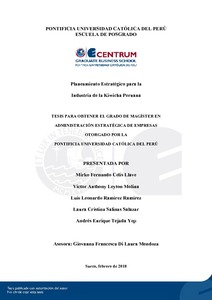| dc.contributor.advisor | Di Laura Mendoza, Giovanna Francesca | |
| dc.contributor.author | Celis Llave, Mirko Fernando | es_ES |
| dc.contributor.author | Leyton Molina, Víctor Anthony | es_ES |
| dc.contributor.author | Ramírez Ramírez, Luis Leonardo | es_ES |
| dc.contributor.author | Salinas Salazar, Laura Cristina | es_ES |
| dc.contributor.author | Tejada Yep, Andrés Enrique | es_ES |
| dc.date.accessioned | 2018-04-11T22:12:19Z | |
| dc.date.available | 2018-04-11T22:12:19Z | |
| dc.date.created | 2019 | |
| dc.date.issued | 2018-04-11 | |
| dc.identifier.uri | http://hdl.handle.net/20.500.12404/11889 | |
| dc.description.abstract | En el transcurso de su historia, la industria agrícola en el Perú ha experimentado importantes
cambios como consecuencia de las reformas implementadas en este sector. Por otro lado, la
participación de gran parte de la población económicamente activa en la agricultura refleja la
importancia del sector, y su influencia en el desarrollo y la economía del país. En los últimos
años, el Perú se ha convertido en uno de los principales países proveedores de alimentos a
nivel mundial, impulsado principalmente por los tratados comerciales y la amplia variedad de
productos agrícolas. En este contexto, la kiwicha peruana es uno de los alimentos con mayor
oportunidad de crecimiento en el mercado local e internacional. Los antecedentes señalados
determinan el desarrollo de un plan estratégico de la industria de la kiwicha en el Perú, el cual
tiene como principal fin, para el año 2027, la consolidación de este grano en el mercado local,
lo cual implica posicionar la kiwicha peruana en los principales mercados a nivel mundial;
incrementar la productividad e incentivar el consumo del grano, para lo cual se debe atraer
mayor inversión, cuidar el medio ambiente y generar beneficios para los grupos de interés
internos y externos. Lograr estos objetivos se requiere un conocimiento integral de la
actualidad de la industria, desde los agricultores y asociaciones, para mejorar el rendimiento a
través de la capacitación en procesos tecnificados y el uso de buenas prácticas agrícolas,
hasta el despliegue de un plan de marketing para afianzar a la kiwicha en el mercado local y
extranjero. La visión que se plantea para el año 2027 proyecta que la industria de la kiwicha
peruana se consolidará como el primer exportador mundial y como uno de los principales
granos andinos de consumo a nivel nacional. La kiwicha será un símbolo peruano ante el
mundo | es_ES |
| dc.description.abstract | Throughout its history, the agricultural industry in Peru has experienced important changes as
a consequence of the reforms implemented in this sector. Additionally, the participation of a
big part of the agricultural workforce reflects the importance of the sector, and its influence in
the development and the economy of the country. In recent years, Peru has become one of the
main food providing countries worldwide, encouraged mainly by the trade agreements and
the wide variety of agricultural products. In this context, the Peruvian Amarant or kiwicha is
one of the foods with a higher growing opportunity in the local market as well as in the
international market. The background described above determines the development of a
strategic plan of the kiwicha industry in Peru, which has as its main purpose, for the year
2027, the consolidation of this grain in the local market, which implies positioning the
Peruvian kiwicha in the main global markets; increasing its productivity and motivating the
consumption of the grain, for which more investment has to be lured, protecting the
environment and generating benefits for the internal and external stakeholders. Achieving
these objectives takes a comprehensive understanding of the current status of the industry, by
the farmers and the associations, in order to improve its yield through the training in modern
processes and the application of good agricultural practices, up to the deployment of a
marketing plan in order to consolidate the kiwicha in the local and foreign markets. The
vision formulated for 2027 envisions that the Peruvian kiwicha industry will consolidate as
the top worldwide exporter and as one of the main Andean grains of consumption
nationwide. The Amarant or kiwicha will become a Peruvian symbol before the world. | es_ES |
| dc.language.iso | spa | es_ES |
| dc.publisher | Pontificia Universidad Católica del Perú | es_ES |
| dc.rights | info:eu-repo/semantics/openAccess | es_ES |
| dc.rights.uri | http://creativecommons.org/licenses/by-nc-nd/2.5/pe/ | * |
| dc.subject | Kiwicha -- Producción -- Perú | es_ES |
| dc.subject | Cultivos andinos -- Perú | es_ES |
| dc.subject | Planificación estratégica | es_ES |
| dc.title | Planeamiento estratégico para la industria de la kiwicha peruana | es_ES |
| dc.type | info:eu-repo/semantics/masterThesis | es_ES |
| thesis.degree.name | Maestro en Administración Estratégica de Empresas | es_ES |
| thesis.degree.level | Maestría | es_ES |
| thesis.degree.grantor | Pontificia Universidad Católica del Perú. CENTRUM | es_ES |
| thesis.degree.discipline | Administración Estratégica de Empresas | es_ES |
| renati.discipline | 413307 | es_ES |
| renati.level | https://purl.org/pe-repo/renati/level#maestro | es_ES |
| renati.type | https://purl.org/pe-repo/renati/type#tesis | es_ES |
| dc.publisher.country | PE | es_ES |
| dc.subject.ocde | https://purl.org/pe-repo/ocde/ford#5.02.04 | es_ES |






